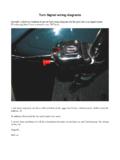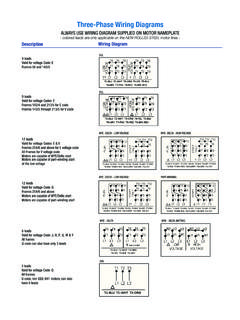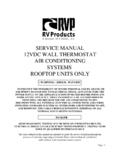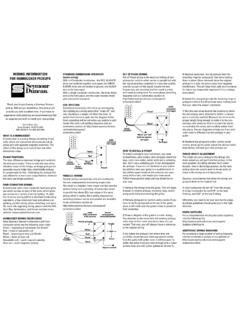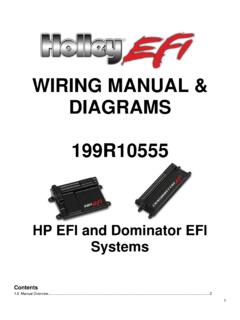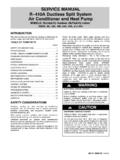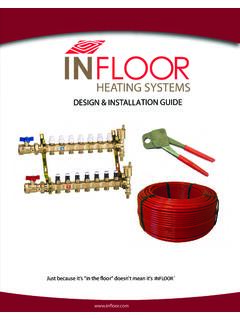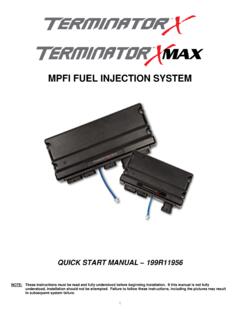Transcription of Basic Wiring for Motor Contol - Eaton
1 Basic Wiring for Motor Contol Technical Data New Information Table of Contents April 2007. Description Page M OL Language of Control .. 2. L1 Symbols .. 3. T1. M OL T2 Circuitry of a Starter .. 4. AC. L2 Two-Wire Control.. 6. Lines M OL T3 Three-Wire Control .. 6. L3 Motor Control Power Transformers .. 8. Control Circuit Wiring of CPTs .. 9. Reversing Starters .. 10. Cover Control Circuits .. 11. Start M. Stop OL Start/Stop with Pilot .. 11. A1 A2. 1 2 3 95 96. Hand/Off/Auto .. 11. M Forward/Reverse with 2 Pilots .. 12. Glossary .. 13. Introduction A Refresher Course for the Product Modifier This text is designed as a refresher course for personnel who will have the responsibility of modifying Cutler- Hammer products from Eaton 's electrical business to meet their customer's needs.
2 The scope of the material has been necessarily limited. It covers the most commonly used products and Wiring sche- matics. Despite its brevity, you are cautioned not to skim lightly over the content. The Benefit of Satisfaction and Confidence There is great satisfaction in being good at something. Individuals who attain knowledge in a particular field have confidence and the respect of their associates. Studying this text will provide you with a fundamental and solid knowledge of control Wiring and the products you will be working with. When you are able to offer your customers tailor-made solu- tions to their product needs, you are sure to feel great satis- faction.
3 And, when your endeavors help add to the profitability of your organization, you will very likely enjoy greater benefits. We hope you agree after finishing this course of study. TD03309004E For more information visit: Technical Data Basic Wiring for Page 2 Effective: April 2007 Motor Contol Language of Control Circuit diagrams communicate information quickly and Line diagrams show circuits of the operation of the efficiently. controller. Every trade and profession has its method of communicat- Line diagrams , also called schematic or elementary dia- ing ideas and information quickly and efficiently.
4 In addition grams, show the circuits which form the Basic operation of to the terminology shown in the glossary of this text, dia- the controller. They do not indicate the physical relation- grams play a vital role of communication in electrical cir- ships of the various components in the controller. They are cuits. A knowledge of symbols, diagrams and terminology an ideal means for troubleshooting a circuit. will aid in our understanding of electrical control. Figure 2 shows a typical line or schematic diagram. The Basic language of control is the circuit diagram. Consist- ing of a series of symbols interconnected by lines to indicate the flow of current to the various components, it tells in M OL.
5 Remarkably short time a series of events that would take L1. many words to explain. Circuit diagrams are available in two T1. M OL. formats. AC T2. L2. Lines Wiring diagrams show the connections to the controller. M OL T3. L3 Motor Wiring diagrams , sometimes called main or construc- tion diagrams , show the actual connection points for the wires to the components and terminals of the controller. They show the relative location of the components. They can be used as a guide when Wiring the controller. Start M OL. Stop A1 A2. Figure 1 is a typical Wiring diagram for a three-phase mag- 1 2 3 95 96.
6 Netic starter. M. L1 L2 L3 Figure 2. Typical Line or Schematic Diagram 1. A1 A2 2. M. 3. 98 Start 3. OL 97. 2. 96 Stop 1. Reset T1 T2 T3 95. 3-Phase Motor Figure 1. Typical Wiring Diagram For more information visit: TD03309004E. Basic Wiring for Technical Data Motor Contol Effective: April 2007 Page 3. Symbols Standardized symbols make diagrams easier to read . On Contacts and Switches or Pushbuttons, you will find a designation of NO or NC (Normally Open or Normally Both line and Wiring diagrams are a language of pictures. It Closed). This refers to the state of the contacts when power is not difficult to learn the Basic symbols.
7 Once you do, you is not applied to them. In tracing circuits on line diagrams , are able to read diagrams quickly, and can often understand you will need to visualize the opening or closing of the con- a circuit at a glance. The more you work with both line and tacts when the circuit is energized or de-energized. Wiring diagrams , the better you will become in analyzing them. The American Standards Association (ASA) and the National The pushbutton symbols shown in Figure 3 represent Electrical Manufacturers' Association (NEMA) are the agen- Momentary pushbuttons. The contacts will change state cies which are responsible for setting up and maintaining the from their normal position only for as long as your finger is symbol standards.
8 Because of these standards, you will be on the button. able to read all diagrams that come across your workbench. Later in this text, we will be working with actual applications Figure 3 shows many of the most commonly used symbols and line diagrams . So study these symbols carefully please. on Control diagrams . Coils Single Voltage Relays Thermal 98. Magnet Coils Overload 97. Dual Voltage Link OL. Magnet Coils 96. 12 34 Reset 95. High Time W/Inst. Voltage Delay Inter- lock Links TR. 1 23 4. Switches Pushbutton Low Normally Closed Voltage Pushbutton Contacts Normally Normally Open Open Limit Switch Normally Open Normally Closed Limit Switch Held Open Limit Switch Timed Normally Open Closed Limit Switch Timed Held Closed Closed Selector Jog Run Switch Fuse Standard Two-Position Indicator Standard A-Amber A.
9 Lights R-Red B. R. G-Green Selector Off B-Blue Switch Hand Auto Motors AC Single-Phase Three-Position T1 T2. A. B. Two-Wire Three-Phase T1 T2 T3 Pilot Devices Transformers Low Voltage H1 PT H2. Control Transformer X1 X2. Figure 3. Standard Diagram Symbols TD03309004E For more information visit: Technical Data Basic Wiring for Page 4 Effective: April 2007 Motor Contol Circuitry of a Starter The two circuits of a Motor starter are the power and con- Separate voltages supplied by Control Power Transformers. trol circuits. Another method for supplying separate voltages for power There are two circuits to a starter the Power Circuit and and control circuits, is to use a Control Power Transformer.
10 The Control Circuit. These are sometimes also referred to as Control Circuit Transformers. One voltage source is used to supply the The electricity that passes through the contacts of the Motor . This same voltage is also supplied to the primary side starter, through the overload relay, and out to the Motor , is of the transformer. The transformer's secondary supplies the called the power circuit. The thick lines of Figure 4 represent voltage to operate the magnet coil in the control circuit. A. this power circuit. It is the power circuit that passes electric- more detailed explanation of transformers can be found on ity to the Motor enabling it to run.










